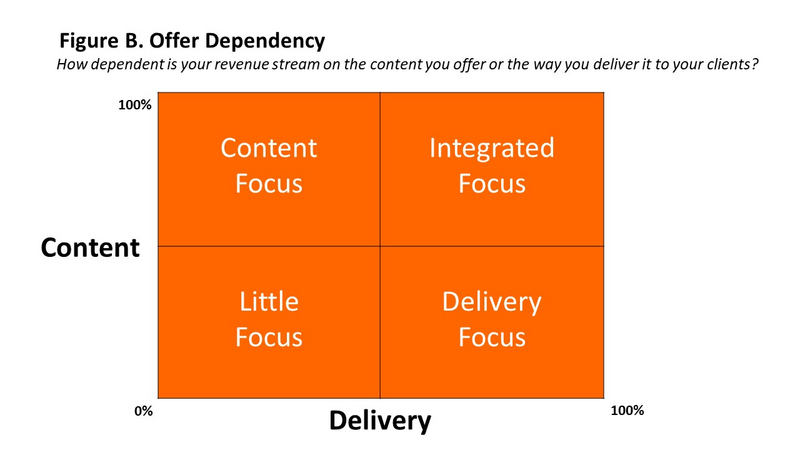ATD Blog
Are You in the Content or Delivery Business?
Tue Oct 01 2019

My previous blog post asked a similar question about how you recognize what business you are in. So, how do you know whether you are in the education or training business? The extent to which you answer that question will help you focus your offer both on content and delivery. While the answer is rarely black and white, that first question certainly invites reflection, as does the question of the content or delivery focus for your business. More often than not, we straddle fences in the interest of satisfying our customers’ needs, trying to successfully be all things to all people instead of focusing on differentiating our business so that it can address client challenges better than any other firm in its space. This post will address the second question, which when combined with the answer to the one posed in the previous entry, should help you decide just what business you are in and how that affects the way you go to market.
The introduction of technology-enabled learning platforms to our industry has somewhat muddied the waters of differentiation in that it has forced many firms to make this difficult decision regarding the business they are in. While ultimately this may be seen as a positive outcome, it comes with its own challenges in that you are unlikely to be all things to all people and in so doing, have to turn down business. While in the long run this may be the best decision for you and your clients, it is difficult to do when your client expresses enough confidence in you to take on engagements that may not be exactly in your wheelhouse.
Thus is the case with the distinction between being a content or delivery business. It isn’t that you can’t be both. Most firms see themselves providing a content solution that’s delivered in a specific manner. While you don’t necessarily have to choose one over the other, you must realize that often the knowledge, skills, and resources required to be great at both are quite different and affect the complexion of your business. What is your offering, who needs it, how can it best be delivered, and are you excellent at providing it?
So, what do I mean by content or delivery? Simply put, is your business based on certain intellectual property you “own” such as a leadership theory, a sales process, or a customer service model? Do you have a proprietary assessment tool, a unique business simulation, or your own home-grown LMS? Have you invented your own differentiated business process? If you don’t have any of these—and most of our industry doesn’t—then you are probably cutting and pasting a good deal of existing and relatively public domain work to produce a composite framework of some type. In this case, your best opportunity to gain clientele is through the unparalleled delivery of your services since your offer is probably not that differentiated from your competition. By the way, this isn’t a bad approach because delivery often trumps content when done well.
The reason this distinction is so important, however, is that it should clearly define your go-to-market strategy. That is, what do you want to trumpet as your unique value proposition that you can fully support as the solution to your clients’ business challenges? Perhaps a couple two-by-two frameworks will help clarify this for you.
Figure A represents your offer capability vis-à-vis your industry competition. That is, is your offer totally unique in that your firm owns its content or delivery? Or, is it relatively the same, can be readily imitated by slight tweaks, and looks pretty much like most of your competitors’ offerings?

Figure B represents your offer dependency, again relative to your competition. That is, what is the extent to which your revenue sources depend on your content or delivery?

Combining the two axes in both two-by-two frameworks can help you determine what business you are in, how competitively differentiated you could be, where to focus your attention and resources, and thus the most appropriate go-to-market strategy you should implement. For example, plotting your firm in either the upper-left or (far) lower-right quadrants strongly suggests you are either a content or delivery-driven company and should focus accordingly on your resources. These are the clearest cases. But what if you find yourself in the upper-right quadrants, meaning you not only own unique content but you deliver it in a way few competitors can? What would this mean for your approach to the market?
Most telling, however, would be if your honest self-assessment results in a plot in either of the lower- left quadrants. That is, you are neither unique with your content nor the way you deliver it, and your revenue generation is split between your content and delivery methodology. This doesn’t mean you can’t compete, but your competitive advantage can be found in other ways, perhaps through exceptional service mentioned earlier or even very competitive pricing. The key to these two tools is first to be honest in your self-assessment. Otherwise, the exercise is fruitless. Second, and equally important, is plotting your competitors. Be careful with where you place them in ensuring it is not your wishful thinking, but rather a very honest and sobering assessment of where you stand relative to them.
The questions you need to ask yourself at this point are these:
Can you make an honest assessment and plot where you and your competition fall?
Based on this plotting, how do you go to market appropriately with your messages and target audiences?
What can you do to create a competitive advantage given your current positioning?
As you build your business, have you thoroughly thought through what business you are in? Do you have a good understanding of who your target customers are? And, do you fully understand what your customers and their audiences really need in a learning solution?
For more insight, check out my book The Complete Guide to Building and Growing a Talent Development Firm.
You've Reached ATD Member-only Content
Become an ATD member to continue
Already a member?Sign In
